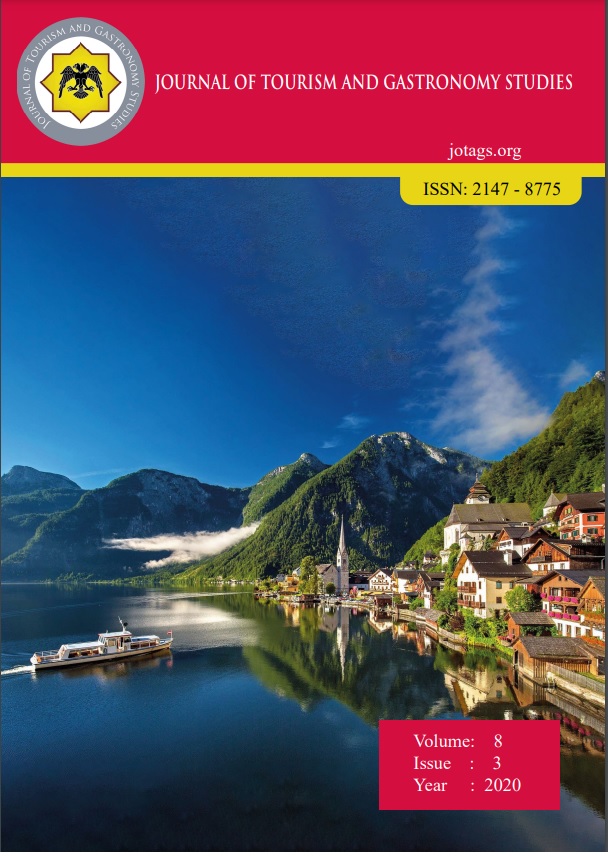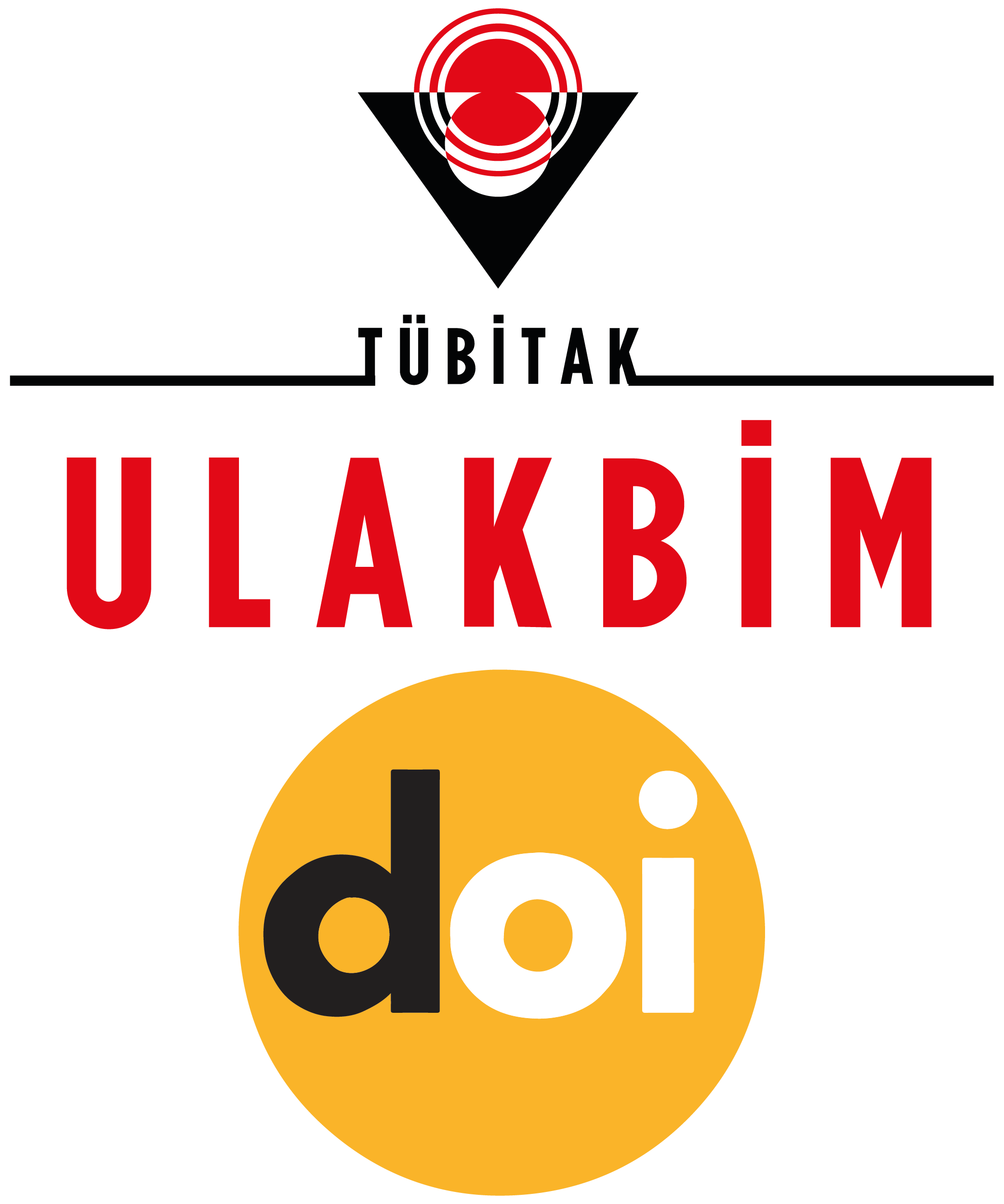Turist Duyguları, Turist Memnuniyeti, Destinasyon Aşkı ve Destinasyon Sadakati Arasındaki Yapısal İlişkinin Belirlenmesi: Bozcaada Örneği (Determination of the Structural Relationship Between Tourist Feelings, Tourist Satisfaction, Love for Destination and Destination Loyalty: The Case of Bozcaada)
DOI:
https://doi.org/10.21325/jotags.2020.648Keywords:
Destination love, Destination loyalty, Tourist emotions, Tourist satisfaction, BozcaadaAbstract
With the increase in international tourist arrivals and tourism revenues, competition between destinations has become more challenging. In these competitive conditions, destinations need differentiation to increase their preferability and should protect existing tourism markets. In order to achieve these for tourism destinations, it is very important to create destination loyalty and a destination brand. In this study, the structural relationships between tourist emotions, tourist satisfaction, destination love and destination loyalty were examined. Using the convenience sampling method, data were collected with online survey from 448 tourists between 21/02/2020 and 2/05/2020. Explanatory and confirmatory factor analysis was applied to reveal the structures in the research. Research hypotheses were tested by structural equation modeling. As a result of the research, tourist emotions have positive effect on tourist satisfaction and destination love; destination love has positive effect on destination loyalty and tourist emotions, tourist satisfaction and destination love have positive effects on destination loyalty. According to the research results, some suggestions are offered for Bozcaada.
References
Adinegara, J., Suprapti, N. W. S., Yasa, N. N. K., & Sukaatmadja, I. (2017). Antecedents and consequences of tourist satisfaction: A literature review. Asean Marketıng Journal, 9(1), 40-53.
Akama, J. S., & Keithi, M. D. (2003). Measuring tourist satisfaction with Kenya's safari. Tourism Management, 24, 73-81.
Akhoondnejad, A. (2018). Loyalty formation process of tourists in sporting event: The case of Turkmen horse races. Journal of Hospitality and Tourism Management, 34, 48-57.
Akkuş, G. (2019). Destinasyon bileşenleri ile duygusal deneyimler arasındaki ilişki ve değişkenlerin davranışsal niyet üzerindeki etkisi. Elektronik Sosyal Bilimler Dergisi, 18(71), 1261-1277.
Andriotis, K., Foroudi, P., & Marvi, R. (2020). Heritage destination love. Qualitative Market Research, Vol. ahead-of-print No. ahead-of-print. https://doi.org/10.1108/QMR-03-2020-0038
Aro, K., Suomi, K., & Saraniemi, S. (2018). Antecedents and consequences of destination brand love: A case study from Finnish Lapland. Tourism Management, 67, 71-81.
Atsız, N., & Türkmen, S. (2020). Destinasyon aşkının destinasyon sadakati üzerindeki etkisi: Bozcaada örneği. Türk Turizm Araştırmaları Dergisi, 4(3): 2018-2030.
Awang, Z. (2012). Research Methodology and Data Analysis. Penerbit University Teknologi MARA Press.
Azhar, M. E., Prayogi, M. A., & Sari,M. (2018). The role of marketing mix and service quality on tourist satisfaction and loyalty at Samosir. Independent Journal of Management & Production, 10(5), 1662-1678.
Başarangil, İ., & Ulaş, Ş. (2018). Destinasyon Çelim unsurlarının ziyaretçi tatmini üzerine etkisi: Kırklareli ili örneği. Pamukkale Üniversitesi Sosyal Bilimler Enstitüsü Dergisi, 33, 189-204.
Birdir, K., & Bal, E. (2013). Turist tatmini ve şikâyetleri ile geri dönme eğilimleri arasındaki ilişki: Antalya’ya gelen yabancı turistler üzerinde bir araştırma. Çağ Üniversitesi Sosyal Bilimler Dergisi, 10(2), 63-81.
Carroll, B. A., & Ahuvia Chaim, A. (2006). Some antecedents and outcomes of brand love. Market Lett, 17, 79–89.
Chen, C.-F., & Tsai, D. C. (2007). How destination ımage and evaluative factors affect behavioral ıntentions. Tourism Management, 28, 1115–1122.
Chen, J., & Gürsoy, D. (2001). An investigation of tourists’ destination loyalty and preferences. International Journal of Contemporary Hospitality Management, 13(2), 79-85.
Darren, G., & Mallery, P. (2010). SPSS for windows step by step: A simple guide and reference, 17.0 update (10 ed.) Pearson Education India.
Del Bosque, I. R., & San Martin,H. (2008). Tourist satisfaction a cognitive affective model. Annals of Tourism Research, 35(2), 551-573
Deniz, T. (2019). Turizm ve biyoçeşitlilik. Safran Kültür ve Turizm Araştırmaları Dergisi, 2 (3), 323-339.
Di̇ker, O., Deni̇z, T., & Çeti̇nkaya, A. (2016). Jeoturizm kapsamında Safranbolu’da coğrafi kaynakların değerlendirilmesi ve Safranbolu jeoturizm potansiyelinin belirlenmesi. Karabük Üniversitesi Sosyal Bilimler Enstitüsü Dergisi, 6 (2), 334-348.
Dmitrovic, T., Cvelbar, L., Kolar, T., Brencic, M., Ograjensek, I., & Zabkar, V. (2009). Conceptualizing tourist satisfaction at the destination level. International Journal of Culture, Tourism and Hospitality Research. 3(2), 11 –126.
Fornell, C., & Larcker, D. F. (1981). Evaluating structural equation models with unobservable variables and measurement error. Journal of Marketing Research, 18(1), 39-50.
Gillath, O., McCall, C., Shaver, P. R., & Blascovich, J. (2008). What can virtual reality teach us about prosocial tendencies in real and virtual environments? Media Psychology, 11(2), 259-282.
Goossens, C. (2000). Tourism Information and Pleasure Motivation. Annals of Tourism Research, 27(2), 301-321.
Grappi, S., & Montanari, F. (2011). The role of social ıdentification and hedonism in affecting touristre-patronizing behaviours: the case of an Italian festival Silvia. Tourism Management, 32, 1128-1140.
Gretzel, U., Fesenmaier, D., Formica, S., & O’Leary, J. (2005). Searching for the future: Challenges faced by destination marketing organizations. Journal of Travel Research, 45(2), 116-126.
Hair, J. F., Black, W. C., Babin, B. J., & Anderson, R. E. (1998). Multivariate data analysis. Upper Saddle River, NJ: Prentice Hall.
Hosany, S., & Gilbert, D. (2010). Measuring tourists' emotional experiences toward hedonic holiday destinations. Journal of Travel Research, 49(4), 513 –526.
Hosany, S., & Prayag, G. (2013). Patterns of tourists’ emotional responses, satisfaction and ıntention to recommended. Journal of Business Research, 66, 730-737.
Hultman, M., Skarmeas, D., Oghazi, P., & Beheshti, H. M. (2015). Achieving tourist loyalty through destination personality, satisfaction, and ıdentification. Journal of Business Research, 68(11), 2227-2231.
Jiang, K. (2019). An exploration of destination brand love among Theme-Park based tourists and excursionists (Doktora tezi, Waterloo Üniversitesi, Kanada). Alınan adres: https://uwspace.uwaterloo.ca/handle/10012/14469
Karagöz, D. (2018). Destinasyon uzantılarının turistlerin duygusal tepkileri ve davranışsal niyetleri ile ilişkisi. Journal of Tourism and Gastronomy Studies, 6(3), 171-194.
Kim, H., Woo, E., & Uysal, M. (2015). Tourism experience and quality of life among elderly tourists. Tourism Management, 46, 465-476.
Kozak, M., & Rimmington, M. (1999). Measuring tourist destination competitiveness: Conceptual considerations and empirical findings. International Journal of Hospitality Management, 18, 273-283.
Ladhari, R. (2006). The movie experience: A revised approach to determinants of satisfaction. Journal of Business Research, 60, 454-462.
Ladhari, R. (2009). Service quality, emotional satisfaction, and behavioural ıntentions: A study in the hotel ındustry. Managing Service Quality, 19(3): 308-331.
Lee, C.-K., Yoon, Y. S., & Lee, S.-K. (2007). Investigating the relationships among perceived value, satisfaction, and recommendations: the case of the Korean DMZ. Tourism Management, 28(1), 204-214.
Lee, J.-S., Lee, C.-K., & Choi, Y. (2010). Examining the role of emotional and functional values in festival evaluation. Journal of Travel Research, 50(6), 685-696.
Lee, K.-H., & Hyun, S. S. (2016). The effects of perceived destination ability and destination brand love on tourists’ loyalty to post-disaster tourism destinations: the case of Korean tourists to Japan. Journal of Travel & Tourism Marketing, 33, 613–627.
Lee, Y.-K., Lee, C.-K., Lee, S.-K., & Babin, B. J. (2008). Festivalscapes and patrons' emotions, satisfaction, and loyalty. Journal of Business Research, 61(1), 56-64.
Lončarić, D., Perišić Prodan, M., & Dlačić, J. (2017). Co-creating tourist experiences to enhance customer loyalty and travel satisfaction. Tourism in Southern and Eastern Europe, 4, 321-334.
Machleit, K. A., Eroglu, S. A., & Mantel, S. P. (2000). Perceived retail crowding and shopping satisfaction: What modifies this relationship? Journal of Consumer Psychology, 9(1), 29-42.
Mercan, Ş. O., & Özkök, F. (2013). Sürdürülebilir turizmde yerel yönetimlerin önemi; Bozcaada örneği. Sosyal ve Beşeri Bilimler Dergisi, 5(1): 409-418.
Patricia, M. (2009). Brand management for international hotels (1st ed.). Global Media.
Peng, N., Chen, A., & Hung, K.-P. (2017). The effects of Teppanyaki restaurant stimuli on diners’ emotions and loyalty. International Journal of Hospitality Management, 60, 1-12.
Prayag, G., & Ryan, C. (2012). Antecedents of tourists’ loyalty to Mauritius: The role and ınfluence of destination ımage, place attachment, personal ınvolvement, and satisfaction. Journal of Travel Research, 20(10), 1-15.
Prayag, G., Hosany, S., Muskat, B., & Del Chiappa, G. (2017). Understanding the relationships between tourists’ emotional experiences, perceived overall ımage, satisfaction, and ıntention to recommend. Journal of Travel Research, 56(1), 41–54.
Rholes, W. S., & Simpson, J. A. (2004). Adult attachment: Theory, research, and clinical implications. Guilford Publications.
Severt, D., Wang, Y., Chen, P.-J., & Breiter, D. (2007). Examining the motivation, perceived performance, and behavioral ıntentions of convention attendees: Evidence from a regional conference. Tourism Management, 28, 399-408.
Sharma, P., & Nayak, J. K. (2019). The role of destination image as a mediator between tourists’ emotional experiences and behavioral ıntentions: A study of wellness tourism. Journal of Destination Marketing & Management, 28, 41-52.
Shen, Y. S., Huang, S., Choi, H.-S. C., & Joppe, M. (2016). Examining the role of satisfaction and brand love in generating behavioral intention. Travel and Tourism Research Association, Amherest-Kanada.
Shujaat, S., Durrani, B., Abrar, K., & Rashid T. (2018). Brand love- some antecedents and consequences: an empırıcal study of the retaıl ındustry. International Journal of Sales, Retailing and Marketing, 7(2), 26-38.
Smith, S. (1994). The tourism product. Annals of Tourism Research, 21(3), 582-595.
Su, L., Hsu, M. K., & Swanson, S. (2017). The effect of tourist relationship perception on destination loyalty at a world heritage site in China: The mediating role of overall destination satisfaction and trust. Journal of Hospitality & Tourism Research, 41(2), 180-210.
Suhartanto, D., Brien, A., Primiana, I., Wibisono, N., & Triyuni, N. N. (2020). Tourist loyalty in creative tourism: the role of experience quality, value, satisfaction, and motivation. Current Issues in Tourism, 23(7), 867-879.
Swanson, K. (2015). Place brand love and marketing to place consumers as tourists. Journal of Place Management and Development, 8(2), 142-146.
Thomson, M., MacInnıs, D., & Park, W. (2005). The ties that bind: Measuring the strength consumers’ emotional attachments to brands. Journal Of Consumer Psychology, 15(1), 77–91.
Tlili, H. T., & Amara, D. (2016). Towards emotional experience and place attachment as tourist satisfaction attributes. Journal of Business & Economic Policy, 3(3), 108-119.
Tsai, S.-P. (2011). Strategic relationship management and service brand marketing. European Journal of Marketing, 45(7/8), 1194-1213.
Tsai, S.-P. (2014). Love and satisfaction drive persistent stickiness: Investigating ınternational tourist hotel brands. International Journal of Tourism Research, 16, 565-577.
Türkmen, S., & Köroğlu, A. (2017). Destinasyon kişiliği araştırması: Türkiye-Yunanistan örneği. Balıkesir Üniversitesi Sosyal Bilimler Enstitüsü Dergisi, 20(37): 397-429.
Uçkun, G., Konakay, G., & Ergen, B. (2016). Destinasyon imajı algısındaki değişimin literatür incelemesi. Kastamonu Üniversitesi İktisadi ve İdari Bilimler Fakültesi Dergisi, 12(2), 196-224.
Vatan, A., & Bildin, E. (2020). A research evaluating the attitudes of local people towards the effects of tourism in Bozcaada. Journal of Economy Culture and Society, 61(1).
Whang, Y.-O., Allen, J., Sahoury, N., & Zhang, H. (2004). Falling in love with a product: The structure of a romantic consumer-product relationship. Advances in Consumer Research, 31, 320-327.
Wong, J., Wu, H. C., & Cheng, C. C. (2015). An empirical analysis of synthesizing the effects of festival quality, emotion, festival ımage and festival satisfaction on festival loyalty: A case study of Macau food festival. International Journal of Tourism Research, 17(6), 521-536.
Yang, J., Gu, Y., & Cen, J. (2011). Festival tourists’ emotion, perceived value, and behavioral intentions: A test of the moderating effect of festivalscape. In Journal of Convention & Event Tourism, 12(1), 25-44.
Yılmaz, H. (2011). Destinasyon sadakatini etkileyen faktörler: Belek golf turizmi uygulaması (Doktora Tezi). Anadolu Üniversitesi, Eskişehir. Alınan adres: https://tez.yok.gov.tr/UlusalTezMerkezi/tezSorguSonucYeni.jsp
Yuksel, A., & Yuksel, F. (2007). Shopping risk perceptions: Effects on tourists’ emotions, satisfaction and expressed loyalty ıntentions. Tourism Management, 28(3), 703-713.
Bozcaada Belediyesi (2020). Bozcaada hakkında. Alınan adres: http://www.bozcaada.bel.tr/, Erişim Tarihi: 12.07.2020.
Kültür ve Turizm Bakanlığı. Turizm istatistikleri. Alınan adres: http://yigm.kulturturizm.gov.tr/, Erişim Tarihi: 12.07.2020.
Downloads
Published
How to Cite
Issue
Section
License
Copyright (c) 2023 Journal of Tourism & Gastronomy Studies

This work is licensed under a Creative Commons Attribution-NonCommercial 4.0 International License.








